My grandma said, “Exercise shouldn’t be a chore.” She was right. This led me to find the benefits of standing abs exercises. I found standing abs workouts to be a big help. These workouts, often called an abs workout standing up, allow you to engage your core effectively without lying on the floor, making them accessible and enjoyable.
These exercises are great for improving core strength without being on the floor. They’re perfect for beginners or anyone looking for a new routine. A standing ab workout for beginners is a great starting point.
Adding an abs workout to your day can make your core stronger. It’s easy and works well, helping you reach your fitness goals.
Why Standing Ab Workouts Are Game-Changers

Standing ab exercises are more than just floor workouts. They offer a full-body workout that works many muscles at once.
Benefits for People with Mobility Issues
Standing ab workouts are great for those with mobility issues. They’re easy to do without lying down or hurting your back. This accessibility is crucial for individuals who may find traditional floor exercises challenging or painful. Additionally, these workouts can be performed anywhere at home or in a gym, allowing for greater flexibility in fitness routines. Incorporating standing abs exercises into your regimen can significantly enhance your overall fitness experience. This makes them a big plus for many people.
Advantages Over Traditional Floor Exercises
Standing ab exercises work your core in a real-life way. They help improve your posture and balance. This kind of movement is more like what you do every day.
| Exercise Type | Primary Benefits | Secondary Benefits |
|---|---|---|
| Standing Ab Exercises | Improved core strength, Enhanced posture | Better balance, Functional fitness |
| Traditional Floor Exercises | Isolated core strength | Limited functional carryover |
Time-Efficiency Benefits
Standing ab workouts are quick and easy. They can be part of your daily routine or other workouts, making them an excellent choice for those looking to maximize their time. These exercises can easily fit into your schedule at home, in the gym, or even at the office. This saves time for those who are always busy, allowing you to maintain a consistent fitness regimen without requiring extensive time commitments.
The Science Behind Standing Core Exercises

Standing core workouts are great because they specifically work your core muscles. They don’t just work your abs. They also work your back and pelvic muscles.
How Standing Engages Your Core Differently
Standing exercises need more work from your core than lying down ones. This is because standing requires more balance and posture, which are essential for maintaining stability during various activities. When you engage in standing exercises, your body naturally recruits more muscles to stabilize itself, leading to a more comprehensive workout. So, standing exercises can make your core more substantial and stable, enhancing your overall functional fitness and ability to perform daily tasks more efficiently.
Key differences include:
- Increased engagement of stabilizer muscles plays a crucial role in maintaining proper alignment and preventing injuries during physical activities.
- A more significant challenge is balance and coordination, which translates to improved athletic performance and everyday movement efficiency.
- More functional strength gains that can be applied to real-world scenarios, making standing exercises beneficial for fitness enthusiasts and individuals looking to enhance their quality of life.
Functional Fitness and Real-World Strength
Standing exercises are beneficial for everyday life and sports. They help you do daily tasks and sports better. This is because they strengthen your core in a helpful way for actual activities. By engaging multiple muscle groups simultaneously, standing exercises improve core stability and overall body coordination. This integrated approach to fitness ensures that you are better prepared for the physical demands of daily life, whether it’s lifting groceries, playing with children, or participating in competitive sports. Additionally, the emphasis on maintaining balance during these exercises translates to improved agility and responsiveness in various physical situations.
Research on Standing vs. Floor Exercises
Studies show that standing exercises are as good as lying down for working your core. A study found that standing exercises work your core muscles a lot. They can work them as much or more than lying down exercises.
| Exercise Type | Core Muscle Activation | Balance and Coordination Challenge |
|---|---|---|
| Standing Core Exercises | High | High |
| Floor Core Exercises | Moderate to High | Low to Moderate |
Essential Equipment for Standing Ab Workouts
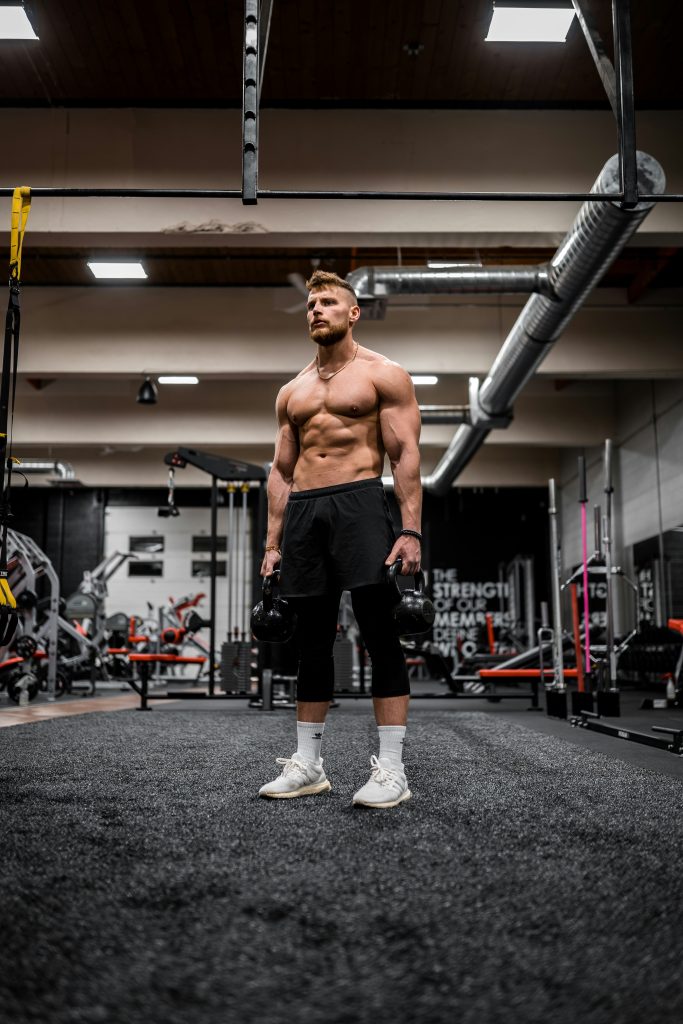
Standing ab workouts are simple and can be done almost anywhere. You don’t need much equipment. This makes it easy for anyone to add these workouts to their day, no matter their fitness level or space.
No-Equipment Options
One big plus of standing ab exercises is that you don’t need any equipment. Your body weight is enough to work your core muscles well. Standing crunches, side bends, and twists are great exercises that work different muscles.
Standing without equipment lets you move freely and can be as good as using weights. Could you keep the correct form and use your core muscles in each move?
Recommended Tools to Enhance Your Workout
Even though you don’t need equipment, some tools can improve your workout. Resistance bands are light, cheap, and can make your exercises harder. They come in different strengths, so they’re suitable for everyone.
A stability ball or medicine ball can also be helpful. They add weight and challenge to your standing ab exercises. Using these tools keeps your workouts fresh and stops you from getting bored.
Creating Space in Your Home
To do standing ab workouts, you need a little space. You want a clear area where you can move freely. Even a tiny spot is enough.
“The key to a successful workout routine is consistency, and having a dedicated space at home can significantly boost your motivation to stick with it.”
Clearing a small area in your living room or office makes it easy to fit in a standing ab workout. It becomes a natural part of your daily routine.
Proper Form and Technique Fundamentals
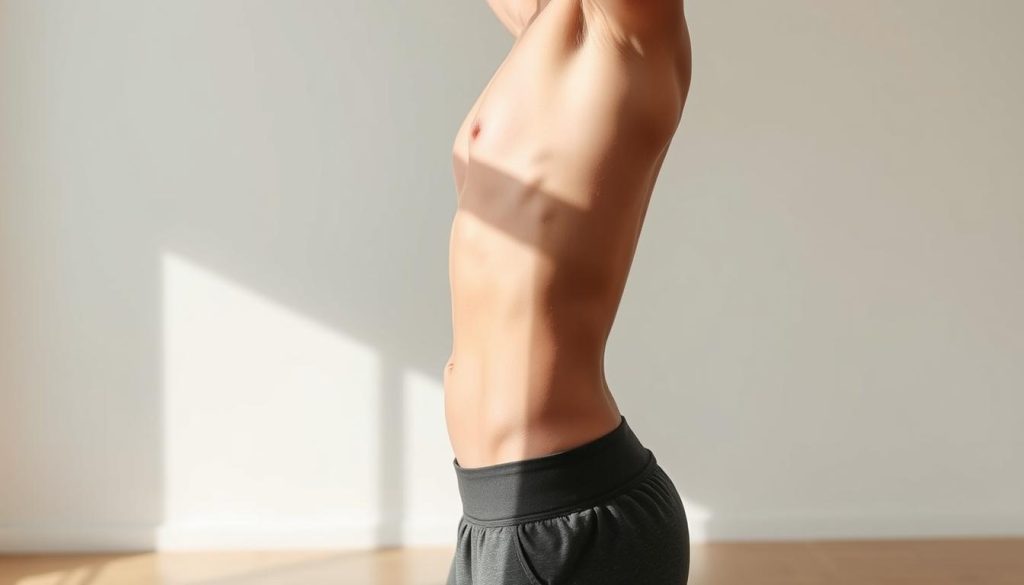
To get the most out of your core exercises in the standing position, it’s key to know the basics. Doing it right helps you work out better and stay safe.
Correct Posture for Maximum Engagement
Standing right is the first step to a good workout. Stand tall with your feet apart, knees a bit bent. Pull your belly button to your spine and keep your shoulders down. This helps your core work better. Maintaining this posture engages your abdominal muscles effectively and supports your back, reducing the risk of injury. Additionally, aligning your head over your shoulders and your shoulders over your hips creates a strong foundation for movement, allowing you to perform exercises with excellent stability and control. This alignment is crucial for maximizing the benefits of your workout and ensuring that each movement targets the correct muscles efficiently.
Breathing Techniques
Breathing right is as important as moving. Proper breathing techniques can significantly enhance your workout efficiency and effectiveness. Breathe deeply before you start any movement, filling your lungs, and then exhale as you squeeze your core during the exertion phase of your exercise. For example, breathe out when you crunch forward and in when you return to the starting position. This rhythm helps maintain your focus and keeps your core engaged throughout the workout. Additionally, consistent breathing patterns can improve your endurance and allow you to perform more repetitions with better form. This keeps your rhythm and helps your core.
Common Form Mistakes to Avoid
Some common mistakes can mess up your abs workout standing up. Don’t arch your back or lean too far forward, as this can create unnecessary strain on your spine and lead to discomfort or injury over time. Maintaining a neutral spine is crucial for protecting your back while engaging your core effectively. Also, please make sure to use your core muscles throughout the entire workout. This means actively engaging your abdominal muscles during each movement, which enhances the exercise’s effectiveness and helps prevent injury. Keep your movements smooth and focused, as erratic or jerky motions can compromise your form and reduce the benefits of your workout. Avoid holding your breath, as it can lead to tension and reduce your workout effectiveness. Instead, practice a steady breathing pattern that allows you to maintain your energy and focus. Inhale deeply during the preparation phase of each exercise and exhale as you exert force, which will help you stay engaged and improve your overall performance.
Abs Workout Standing Up: A Beginner’s Guide
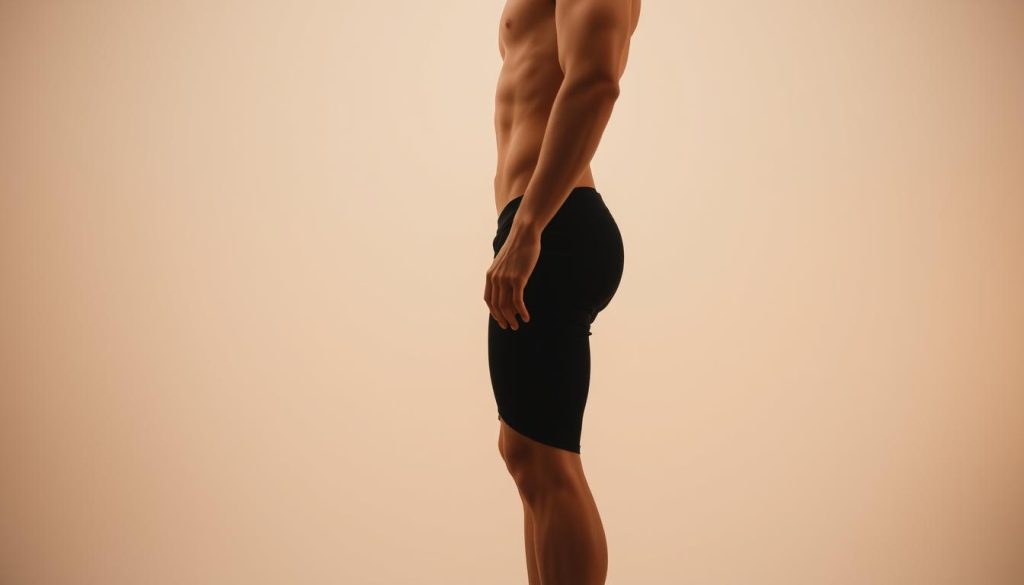
Standing abs exercises are easy and work well. They are perfect for beginners. You don’t need much to start. Let’s look at some simple exercises you can do.
Standing Crunches
Standing crunches are suitable for your core and don’t hurt your back. Stand with your feet apart and hands behind your head, ensuring your posture is upright and your shoulders relaxed. Contract your core muscles and lift your torso by engaging your abdominal muscles effectively. Keep your back straight as you perform the movement and avoid any twisting motion that could lead to strain. Focus on squeezing your abdominal muscles throughout the exercise, enhancing your strength and stability. Remember to breathe steadily; inhale as you prepare and exhale as you lift, which helps maintain your energy and concentration during the workout.
Standing Side Bends
Standing side bends work your obliques. Stand with your feet apart and hands by your sides. Bend to one side, then back to start. Do the same on the other side. This exercise targets your oblique muscles, essential for a well-defined waist, and helps improve your overall flexibility and balance. As you bend, engage your core to support your spine and maintain stability. It’s important to avoid leaning forward or backward; instead, focus on a smooth lateral motion. To increase the challenge, you can hold a weight in one hand while performing the bends, further engaging your muscles and enhancing the workout. Additionally, consider incorporating controlled breathing—exhaling as you bend and inhaling as you return to the starting position. This practice can help you maintain rhythm and concentration throughout the exercise.
Standing Twists
Standing twists work your whole core. Stand with feet apart and hold a lightweight. Twist your torso from side to side, ensuring your hips remain stable and your lower body is engaged. This movement not only targets your oblique muscles but also helps to improve your spinal mobility and posture. Keep your arms straight and core tight, as this will enhance the effectiveness of the exercise and prevent any strain on your back. By maintaining a controlled motion, you can maximize the benefits of this exercise and develop better coordination and balance.
Knee-to-Elbow Touches
Knee-to-elbow touches work many muscles. Stand with feet apart and hands by your sides. Lift your knee to your elbow, switching sides with each move. This boosts coordination and core strength. By engaging multiple muscle groups, including the abdominals, obliques, and hip flexors, this exercise enhances your core stability and improves your overall functional movement. As you perform the exercise, focus on maintaining a strong posture and controlled breathing to maximize effectiveness. Additionally, incorporating variations such as holding the position for a moment or adding a slight twist can further challenge your balance and coordination, making this a versatile and beneficial addition to your workout routine.
Advanced Standing Core Exercises

Advanced standing core exercises, particularly standing abs exercises, offer a new challenge for those who have mastered the basics. These exercises are designed to engage your core muscles more intensely. They provide a more effective workout.
Standing Russian Twists with Weights
Standing Russian twists with weights are great for targeting the obliques. Stand with your feet shoulder-width apart. Hold a weight or medicine ball and twist your torso left and right. This exercise engages the oblique muscles effectively and promotes better balance and stability. To maximize the benefits, ensure that your movements are controlled and deliberate, focusing on the contraction of your core as you twist. You can increase the challenge by using a heavier weight or incorporating a pause at the end of each twist, allowing your muscles to engage more fully. Also, could you perform the exercise on an unstable surface, like a balance pad, to enhance your core activation and coordination further?
Standing Leg Raises
Standing leg raises target the lower abs. Lift one leg towards your chest, keeping it straight and engaging your core to maintain balance throughout the movement. As you raise your leg, focus on squeezing your abdominal muscles to enhance the effectiveness of the exercise. Then lower it back down without touching the floor, allowing your muscles to remain engaged, and repeat on the other side. This controlled motion strengthens the lower abdominal region and improves overall stability and coordination, making it an excellent addition to your core workout routine.
Standing Oblique Crunches
Standing oblique crunches target the obliques and improve rotational strength. This exercise is particularly effective for engaging the muscles on the sides of your abdomen, which play a crucial role in stabilizing your torso during various movements. Stand with your feet shoulder-width apart to establish a solid base. Place your hands behind your head, ensuring your elbows are broad and not pulled forward, which helps maintain proper posture. As you crunch to one side, focus on bringing your elbow towards your hip while keeping your core engaged to maximize the contraction of your oblique muscles. Then, return to the starting position and repeat the motion on the other side. Incorporating this exercise into your routine enhances your core strength and improves your overall balance and coordination, making it a valuable addition to any fitness program.
Dynamic Plank Variations from Standing
Dynamic plank variations from a standing start in a standing position. Then bend forward to engage your core in a plank-like position. Return to standing. This dynamic movement challenges your core stability and strength.
| Exercise | Target Muscle | Repetitions |
|---|---|---|
| Standing Russian Twists with Weights | Obliques | 15-20 per side |
| Standing Leg Raises | Lower Abs | 12-15 per leg |
| Standing Oblique Crunches | Obliques | 15-20 per side |
| Dynamic Plank Variations | Entire Core | 10-12 repetitions |
Adding these advanced standing core exercises to your routine will challenge your core muscles in new ways. By engaging in these exercises, you target your obliques and lower abs and enhance your overall stability and posture. This improves strength and stability, translating into better performance in daily activities and other physical workouts. As you incorporate these movements, you’ll likely notice increased endurance and coordination, allowing you to perform various exercises more efficiently and effectively.
Complete Standing Abdominal Workout Routines
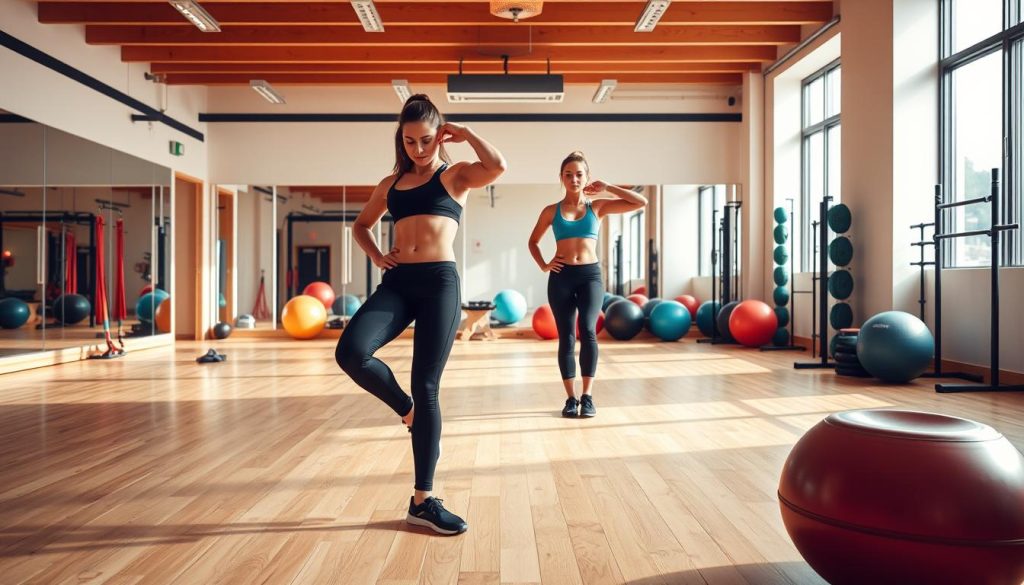
Let’s explore standing abdominal workout routines for all fitness levels, explicitly focusing on standing abs exercises. We’ve learned the benefits and how to do them. Now, we can make routines that meet different needs.
Standing ab workouts are flexible and easy to do anywhere, making them an excellent choice for standing abs exercises. They work for beginners and advanced exercisers alike. There’s a routine for everyone’s goals.
10-Minute Quick Core Blast
Need a quick core workout? Try a 10-minute routine. It includes:
- Standing crunches: 3 sets of 20 reps
- Standing side bends: 3 sets of 15 reps per side.
- Standing twists: 3 sets of 20 reps
20-Minute Full Core Workout
Want a complete core workout? Try a 20-minute routine. It might have:
- Standing Russian twists with weights: 3 sets of 15 reps per side
- Standing leg raises: 3 sets of 20 reps.
- Standing oblique crunches: 3 sets of 15 reps per side
- Dynamic plank variations from standing: 3 sets of 30 seconds
This is great for those who want to strengthen their core.
30-Minute Advanced Standing Abs Circuit
Would you be ready for a challenge? Try a 30-minute advanced circuit. It includes:
- Advanced standing crunches with rotation: 3 sets of 25 reps.
- Standing side plank variations: 3 sets of 30 seconds per side
- High-intensity standing twists: 3 sets of 30 seconds
This routine is for those who want to push their core to the limit.
How to Progress Between Routines
Want to get better? Here’s how to move up:
- Do more reps or sets as you get stronger. For instance, if you can quickly complete your current sets, consider increasing the number of repetitions or adding a set to your routine. This incremental increase can help to challenge your muscles and improve your endurance continually.
- Could you add weights or resistance to your exercises? Incorporating weights, such as dumbbells or resistance bands, can significantly enhance the effectiveness of your workouts. Start with light weights to ensure proper form, and gradually increase the weight as you become more comfortable and more substantial.
- Try more complex exercises as you get better. As you progress, consider incorporating exercises that engage multiple muscle groups or require better balance and coordination. For example, adding movements like standing medicine ball twists or stability ball exercises can provide a new challenge and keep your workouts fresh.
Always listen to your body. You can adjust your routine to avoid injury and keep improving. If you experience pain or discomfort, you must modify your exercises or take a break as needed. Remember, consistency is key, but so is ensuring you are training safely and effectively.
Incorporating Cardio with Standing Ab Exercises

Adding cardio to standing ab exercises enhances fitness, heart health, and results. Integrating cardio boosts core strength and endurance, elevating heart rate for calorie burning and cardiovascular efficiency. This dynamic approach keeps routines engaging and motivating, leading to more effective workouts.
HIIT Standing Ab Workout
High-Intensity Interval Training (HIIT) mixes cardio with standing ab moves. It has short, challenging exercises followed by rest periods, allowing maximum effort during the work intervals. Try 30 seconds of standing mountain climbers, which engage multiple muscle groups and elevate your heart rate, then take 30 seconds to rest and recover. Do this for 15-20 minutes to maximize your calorie burn and improve cardiovascular fitness.
- Standing burpees are a full-body exercise that not only targets your core but also boosts your heart rate significantly.
- Jumping jacks with a twist add a rotational element, engaging your obliques while providing a great cardio workout.
- Standing leg raises with quick cardio bursts can be incorporated to challenge your core stability and endurance further, making this routine both practical and dynamic.
Steady-State Cardio with Core Focus
Steady-state cardio is another option. It keeps a steady pace longer, which is ideal for building endurance and promoting fat loss. Maintaining a consistent effort can improve your cardiovascular health and increase your stamina over time.
- Jogging in place while engaging your core elevates your heart rate and strengthens your abdominal muscles, helping to create a more stable and robust core.
- Cycling with core exercises like standing Russian twists is an excellent way to combine lower body strength with core stability, enhancing overall fitness and making your workouts more efficient.
- Dancing with core-focused movements allows for a fun and dynamic way to work out, engaging various muscle groups while improving coordination and rhythm.
This way, you get a good workout for your heart and core.
Standing Ab Workouts for Special Populations
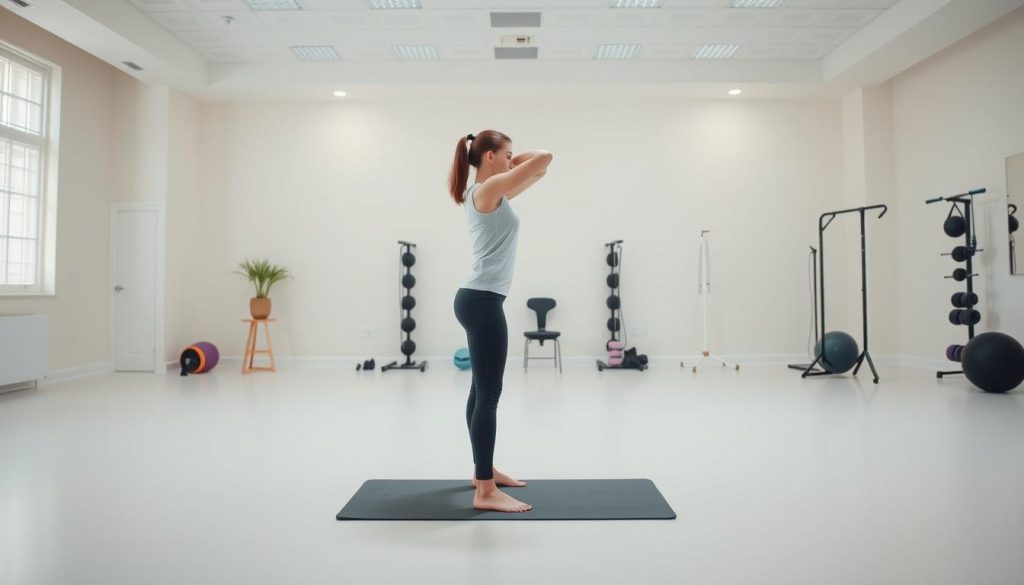
Standing ab workouts are great for seniors, pregnant women, and those with back issues. They are easy to adjust to fit your needs. This makes them perfect for people who can’t do floor exercises.
Modifications for Seniors
Seniors can benefit from standing ab workouts. They help with balance and core strength, which is crucial as it can lower the chance of falls and enhance overall mobility. These workouts are particularly advantageous because they allow seniors to engage their core muscles without falling on the floor, making them more accessible and safer.
Seniors can start with simple exercises like standing marches or leg lifts. These foundational movements strengthen the core and improve coordination and stability. As they become more comfortable and more substantial, they can make these exercises harder by incorporating variations such as adding resistance bands or increasing the duration of each exercise. This gradual progression helps to ensure continued improvement and engagement.
Adaptations for Pregnancy
Pregnant women can do standing ab workouts gently to keep their core strong without hurting themselves. They should focus on their body’s signals and avoid movements causing discomfort. These exercises help maintain core strength, supporting their growing belly and balance.
Exercises like standing pelvic tilts and gentle twists are good. Ensure the pregnant woman is not in pain. Deep breathing can enhance relaxation and oxygen flow to both mother and baby, contributing to a healthier pregnancy.
Options for Those with Back Issues
Standing ab workouts are safer for those with back problems. They avoid floor exercises that might hurt the back, leading to discomfort. Gentle, low-impact exercises promote stability and strengthen the core while supporting the back, which is crucial for those with chronic pain.
Try standing abdominal compressions and modified crunches that don’t pressure the back. Always listen to your body and stop if it hurts, respecting your limits to avoid worsening any issues. Movements focusing on balance can enhance these exercises’ effectiveness and safety.
Standing Abs for Office Workers
Office workers benefit from standing ab workouts that counteract the harmful effects of prolonged sitting, which can cause health issues like poor circulation and fatigue. These exercises can improve posture and reduce back pain, enhancing comfort and productivity.
Try standing torso twists and leg raises during breaks. These exercises strengthen the core and promote better blood flow, providing a refreshing break from sitting and combating the sluggishness of long desk work.
Nutrition Tips to Complement Your Standing Ab Routine

Watch what you eat to get the most out of your standing ab exercises. A good diet helps your fitness goals and makes your workout better.
Good food gives your body what it needs to heal and grow muscles. Standing ab workouts work many muscles. They need the right food to work well and recover.
Foods That Support Core Development
The right foods help your core get more vigorous. Protein from lean meats, fish, and eggs helps muscles fix and grow. Whole grains, fruits, and veggies give you energy for your workouts.
Healthy fats in nuts, seeds, and avocados are key too. They help with hormones and health. Eating a mix of these foods helps your overall routine and fitness.
| Food Group | Examples | Benefits |
|---|---|---|
| Protein | Lean meats, fish, eggs, and tofu | Muscle repair and growth |
| Complex Carbohydrates | Whole grains, fruits, and vegetables | Sustained energy, fiber |
| Healthy Fats | Nuts, seeds, and avocados | Hormone production, overall health |
Meal Timing Around Your Workouts
Eating right before and after workouts matters. A meal with protein and carbs 1-2 hours before gives you energy. This meal should ideally include lean protein sources such as chicken or fish, along with complex carbohydrates like whole grain bread or oatmeal, which provide sustained energy for your workout.
After, eat a mix of protein and carbs in 30-60 minutes. This helps your body recover and repair muscles. Incorporating foods like a protein shake with a banana or Greek yogurt with berries can enhance recovery by supplying the necessary nutrients to rebuild muscle tissue and replenish glycogen stores.
Good nutrition and meal timing boost your standing ab workout. You’ll reach your fitness goals faster. By ensuring that you fuel your body appropriately before and after exercise, you set yourself up for improved performance and quicker recovery, ultimately leading to better results in your core strength and overall fitness journey.
Tracking Progress and Staying Motivated
Working on your core with standing abs workouts requires you to stay motivated. It’s essential to keep track of your progress. This helps you see how far you’ve come.
It’s not just about seeing changes in your body. It’s also about strengthening your body and keeping it standing with core exercises. This helps you make better choices for your workouts.
Realistic Expectations for Results
It’s essential to have realistic goals. Seeing results right away can be challenging, but staying consistent is key to getting stronger. Setting achievable milestones lets you measure your progress effectively and keeps you motivated. Aiming for minor, incremental improvements creates a positive feedback loop that encourages continued effort and commitment to your fitness journey.
Most people start to feel stronger in a few weeks. Celebrating small wins helps keep you going. Recognizing these victories, whether an increase in repetitions or improved endurance, reinforces your dedication and builds confidence. These moments of success are vital as they remind you that progress is being made, even if it sometimes feels slow.
Non-Scale Victories to Celebrate
While the scale is essential, it’s not everything. Non-scale victories like more energy and better posture are big wins. They show you’re improving in ways that aren’t always reflected in numbers. Feeling more energized can enhance productivity and mood, while better posture leads to a more confident appearance. These improvements indicate your body is adapting positively to fitness efforts.
Remembering these victories keeps you positive. Reflecting on how far you’ve come, like fitting into clothes better or completing a workout, can be powerful motivators. These milestones fuel your determination and commitment to push forward, making your fitness journey more rewarding.
Creating a Sustainable Routine
Keeping up with workouts is key. Listen to your body and change your routine as needed. This might mean making exercises easier or adding new ones.
By focusing on progress and celebrating small wins, you can keep going. This helps you stay motivated in your standing abs workout for beginners journey.
Combining Standing Ab Workouts with Other Exercise Modalities
Try mixing standing ab workouts with other exercises. This mix can make your fitness plan better. You’ll get stronger, more flexible, and last longer.
Pairing with Strength Training
Adding standing ab exercises to strength training significantly boosts your workout. It strengthens your core, which is crucial for movement stability and power. A strong core supports your back and enhances everyday task performance, improving balance for both athletic and non-athletic activities.
For example, combining standing ab workouts with leg exercises enhances squats and lunges by engaging core muscles for proper form. This stability reduces injury risk and maximizes workout effectiveness, leading to better posture, which is vital for health and performance.
- Improve overall muscle coordination, essential for executing complex movements efficiently.
- Enhance core strength for better performance in strength training exercises, enabling you to lift heavier weights and achieve your fitness goals more effectively.
- Increase the efficiency of your workout routine by incorporating standing ab exercises, allowing you to target multiple muscle groups simultaneously and save time while still achieving great results.
Incorporating into Yoga Practice
Standing ab workouts match well with yoga. They add new challenges to your core, making each session more dynamic and engaging. These exercises strengthen your abdominal muscles and enhance overall stability, which is crucial for maintaining proper alignment in various yoga poses. This improves your balance in yoga poses, allowing for deeper stretches and more controlled movements.
“Yoga is not just about flexibility; it’s also about strength and balance.” Mixing standing ab workouts with yoga makes your practice better. The combination encourages a holistic approach to fitness, as it builds endurance and resilience in your core, which can lead to improved performance in more advanced yoga techniques. Additionally, a stronger core supports your body during challenging poses, reducing the risk of injury and enhancing your overall experience on the mat.
Adding to Your Running Routine
Runners can benefit from standing ab workouts. They help keep your posture correct and prevent injuries. Do these exercises on rest days or after running.
Standing ab workouts with running make you run better. Listen to your body and adjust your workouts as needed.
Mixing standing ab workouts with other exercises like strength training, yoga, and running is good. You can try different mixes to see what works for you.
Conclusion
Adding an abs workout to your routine can change your game. You now know the benefits and science behind it. This is great for everyone, whether you’re just starting or already advanced.
We talked about what you need to get started. This includes the right equipment and how to do the exercises correctly. You can pick from many exercises to make a routine that fits your life and goals.
So, why not try it out? You can start working on your core while standing. You’ll see the benefits for yourself.
